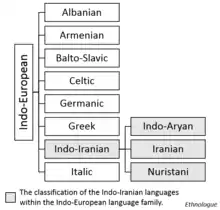Indo-Iranian languages
The Indo-Iranian languages (also Indo-Iranic languages[1][2] or Aryan languages[3]) constitute the largest and southeasternmost extant branch of the Indo-European language family (with over 400 languages), predominantly spoken in the geographical subregion of Southern Asia. They have more than 1.5 billion speakers, stretching from Europe (Romani), Mesopotamia (Kurdish languages, Zaza–Gorani and Kurmanji Dialect continuum[4]) and the Caucasus (Ossetian, Tat and Talysh) eastward to Xinjiang (Sarikoli) and Assam (Assamese), and south to Sri Lanka (Sinhala) and the Maldives (Maldivian), with branches stretching as far out as Oceania and the Caribbean for Fiji Hindi and Caribbean Hindustani respectively. Furthermore, there are large diaspora communities of Indo-Iranian speakers in northwestern Europe (the United Kingdom), North America (United States, Canada), Australia, South Africa, and the Persian Gulf Region (United Arab Emirates, Saudi Arabia).
| Indo-Iranian | |
|---|---|
| Indo-Iranic (Aryan) | |
| Geographic distribution | South, Central, Western Asia, South East Europe and the Caucasus / Total speakers = approximately 1.5 billion in 15 countries |
| Linguistic classification | Indo-European
|
| Proto-language | Proto-Indo-Iranian |
| Subdivisions |
|
| ISO 639-5 | iir |
| Glottolog | indo1320 |
 Distribution of the Indo-Iranian languages | |
The common ancestor of all of the languages in this family is called Proto-Indo-Iranian—also known as Common Aryan—which was spoken in approximately the late 3rd millennium BC. The three branches of the modern Indo-Iranian languages are Indo-Aryan, Iranian, and Nuristani. A fourth independent branch, Dardic, was previously posited, but recent scholarship in general places Dardic languages as archaic members of the Indo-Aryan branch.[5]
Languages


The Indo-Iranian languages consist of three groups: [6]
- Indo-Aryan/Indic, predominantly spoken in the Indian subcontinent
- Iranian/Iranic, predominantly spoken in the Iranian Plateau
- Nuristani, spoken in pockets at the northern intersection of the above regions (Pakistan and Afghanistan)
Indo-Iranian languages are spoken by more than 1.5 billion people.
The languages with the most speakers are a part of the Indo-Aryan group:
- Hindi–Urdu (~590 million as the Indian census often includes Bhojpuri, Awadhi, Magahi, etc.),
- Bengali (205 million),[7]
- Bhojpuri (150 million),[8][9][10]
- Awadhi (40 million),
- Maithili (35 million),
- Marwari (30 million),
- Rajasthani (20 million),
- Chhattisgarhi (18 million),
- Garhwali (2.5 million),
- Kumaoni (2.1 million) as dialects,[11]
- Punjabi (100 million),
- Marathi (90 million),
- Gujarati (50 million),
- Odia (35 million),
- Sindhi (25 million),
- Assamese (24 million),
- Sinhala (19 million),
- Nepali (17 million),
- and Bishnupuriya (12 million).[12]
Among the Iranian branch, major languages are
- Persian (110 million),
- Pashto (40 million),
- Kurdish (35 million),
- and Balochi (8 million). There are also many smaller languages.
| Part of a series on |
| Indo-European topics |
|---|
 |
Ethnologue puts the number of Indo-Iranian languages at 448.[13] Glottolog puts thenumber at 583.[14]
References
- D. D. Mahulkar (1990). Pre-Pāṇinian Linguistic Studies. Northern Book Centre. ISBN 978-81-85119-88-5.
- Annarita Puglielli; Mara Frascarelli (2011). Linguistic Analysis: From Data to Theory. Walter de Gruyter. ISBN 978-3-11-022250-0.
- Jadranka Gvozdanović (1999). Numeral Types and Changes Worldwide. Walter de Gruyter. p. 221. ISBN 978-3-11-016113-7.: "The usage of 'Aryan languages' is not to be equated with Indo-Aryan languages, rather Indo-Iranic languages of which Indo-Aryan is a subgrouping."
- Chatoev, Vladimir; Kʻosyan, Aram (1999). Nationalities of Armenia. YEGEA Publishing House. p. 61. ISBN 978-99930-808-0-0.
- Bashir, Elena (2007). Jain, Danesh; Cardona, George (eds.). The Indo-Aryan languages. p. 905. ISBN 978-0415772945.
'Dardic' is a geographic cover term for those Northwest Indo-Aryan languages which [..] developed new characteristics different from the IA languages of the Indo-Gangetic plain. Although the Dardic and Nuristani (previously 'Kafiri') languages were formerly grouped together, Morgenstierne (1965) has established that the Dardic languages are Indo-Aryan, and that the Nuristani languages constitute a separate subgroup of Indo-Iranian.
- "Indo-Iranian languages - Characteristics of Iranian and Indo-Aryan | Britannica".
- Thompson, Irene. "Bengali". AboutWorldLanguages. Retrieved 29 March 2013.
- Sarrazin, Natalie (28 November 2019). Focus: Popular Music in Contemporary India. Routledge. ISBN 978-0-429-99931-4.
- Simpson, David (22 October 2009). "At the Opium Factory". London Review of Books. Vol. 31, no. 20. ISSN 0260-9592. Retrieved 25 October 2022.
- Magni, Raul. "The Indo Iranian Languages".
{{cite journal}}: Cite journal requires|journal=(help) - Edwards, Viv. "Urdu Today". BBC.
- "Census of India: Family-wise grouping of the 122 Scheduled and Non-Scheduled Languages -2001". www.censusindia.gov.in.
- "Indo-Iranian".
- "Glottolog 4.6 - Indo-Iranian".
Sources
- Chakrabarti, Byomkes (1994). A comparative study of Santali and Bengali. Calcutta: K.P. Bagchi & Co. ISBN 81-7074-128-9
- Nicholas Sims-Williams, ed. (2002). Indo-Iranian Languages and Peoples. Oxford University Press.
Further reading
- "Contact and change in the diversification of the Indo-Iranic languages" (PDF). Dr. Russell Gray.
- Pinault, Georges-Jean. "Contacts religieux et culturels des Indo-Iraniens avec la civilisation de l'Oxus". In: Comptes rendus des séances de l'Académie des Inscriptions et Belles-Lettres, 149e année, N. 1, 2005. pp. 213–257. DOI:https://doi.org/10.3406/crai.2005.22848 ; www.persee.fr/doc/crai_0065-0536_2005_num_149_1_22848
- Pinault, Georges-Jean. "La langue des Scythes et le nom des Arimaspes". In: Comptes rendus des séances de l'Académie des Inscriptions et Belles-Lettres, 152e année, N. 1, 2008. pp. 105–138. DOI:https://doi.org/10.3406/crai.2008.92104 ; www.persee.fr/doc/crai_0065-0536_2008_num_152_1_92104
- Baly, Joseph. Eur-Aryan roots: With their English derivatives and the corresponding words in the cognate languages compared and systematically arranged. Vol. 1. K. Paul, Trench, Trubner & Company, Limited, 1897.
External links
- Swadesh lists of Indo-Iranian basic vocabulary words (from Wiktionary's Swadesh-list appendix)